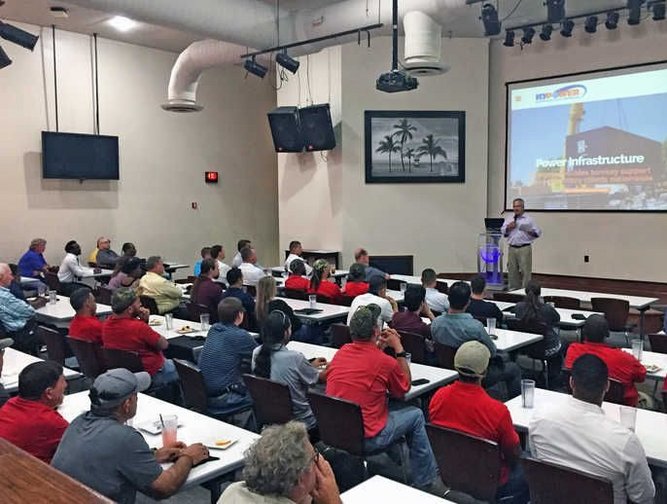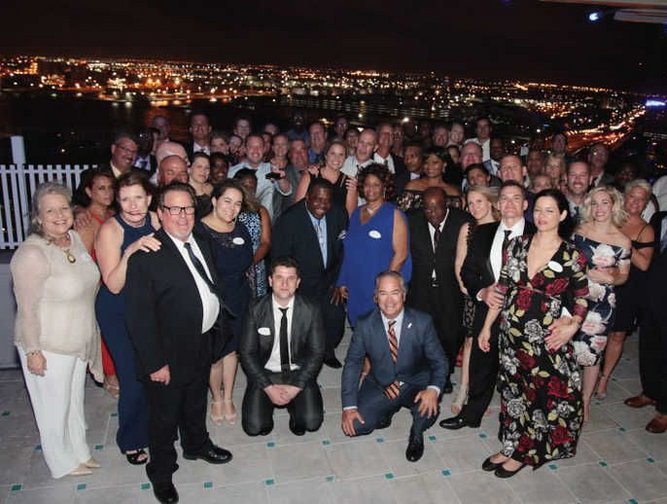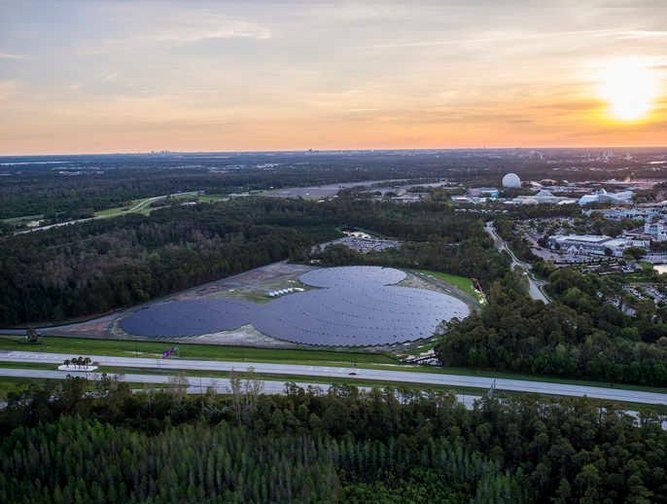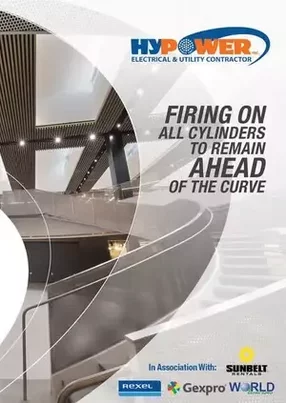How Hypower has remained a US construction leader through embracing technology
One of southeast USA’s largest specialty contractors, Hypower has completed over a thousand projects valued at over $1bn.
The family business’s humble origins and passion to provide quality services has seen it amass a diverse portfolio, grow to over 600 employees and overcome a number of challenges which many others have failed to overcome.
Hypower houses several divisions, ranging from commercial electrical, new construction, renovation, and service and repair; to outside plant power and communications, telecom engineering, airfield lighting, ground mount solar and prime electrical infrastructure projects nationwide.
Established primarily to undertake infrastructure projects in the early 1990s, the company’s specialty niche in runway lighting and airfield lighting systems, and work at New Denver International Airport Runways put it firmly on the map. Its subsequent growth enabled the company to not only spread out geographically but add a significant number of strings to its bow.
“We added traffic signals, high mast lighting, street lighting. We got into the traffic signal business, which filtered into the intelligent transportation system business. This taught us about fiber optic cables and telecommunications,” explains President and CEO of Hypower Inc, Bernard Paul-Hus.
“In 1996, Congress deregulated the telecommunication industry to open up markets to competition by removing regulatory barriers to entry into the telecommunication marketplace, which led to a tremendous amount of investment from the private sector. This created a huge boom in the installation of fiber, which we jumped into. We moved more into telecom, but never got away from our roots in airports.”
Despite the burst of the dot.com bubble, Hypower’s niche markets enabled it to remain afloat without concern, until 9/11.
“9/11 was our first real big challenge because nobody saw that coming,” Paul-Hus explains solemnly. “It wasn't predictable in any kind of economic model, and all of our airfield lighting projects shut down. However, we were fortunate to survive it, and within a year we were back up and running.
“The lesson we learned from that, was that diversity was going to be our path going forward, so we needed to really diversify ourselves into these counter-cyclical niches,” he continues. “The most common thing that gets done by companies like ours is buildings. But even buildings, as we saw in 2008-2012 can pretty much evaporate. When this happens, government-funded and subsidized work stays relatively steady, and if you're good, you're going to continue to win it.
“We ended up with seven divisions, but when the recession hit, we decided to narrow these down into the five groups that we have today.
“We've always been very reactive to the market, trying to stay ahead of what the market's going to do. Right now, all of our divisions are firing on all cylinders, but sooner or later things will slow down. We now have enough foresight, vision and data to anticipate these things, and to weave our way through what the world throws at us.”
Forward planning
By paying significant attention to its tumultuous history, Hypower has applied these lessons towards its future goals. Utilizing predictive analytics, a business intelligence platform, and delivering ongoing training, employees are now able to elevate their abilities within their own specialty niches.
“Our focus needed to be on achieving the highest level of financial acumen at a project management level, and we've been working on that since 2009,” adds Paul-Hus.
“Having project managers that are effectively as good as any accountant at not only the historical, but the predictive part of a project, the forecasting side, has proven to be a huge home run for us. It’s also created the ability to go from micromanaging everybody's decisions, to putting them in this world of ‘If-Then decision making thinking’.
“We believe in autonomous management making decisions. We've created systems and processes that allow staff to make their own decisions based on the data they're being presented with and with the options that are open to them.”
Creating a system where employees are therefore encouraged to look at data on a regular basis and look at their own performance, as well as their team performance, has taken the company to new heights.
“There's a couple of different softwares which we've customized. We’ve now started integrating all those platforms into our proprietary platform, called Hype,” explains Jeff Emerson, Vice President of Electrical Construction.
“This pulls in real-time data, giving project managers and people in the field the systems and information needed to make decisions. It pulls in how much are we spending on material, or how many hours we have spent. What is our production goal? Are we installing as much every day as we need to? What are the open RFIs? It takes all these different systems and integrates them into one.
“We're in the middle of more app development now, that's going to give every single person in the field, no matter what level they are, a daily goal on exactly what they're supposed to achieve,” continues Emerson. “Right now, we do this verbally and with spreadsheets. Now, it will be automated on an iPad or Smartphone that everybody will be able to see first thing in the morning and report on throughout the day.”
Digital disruption
The use of data within construction and design is continuing to reshape traditional practices which have remained relatively unchanged – until recently. For Hypower, it is clear that the company remains keen to take full advantage of embedding new technologies across its operations.
By strengthening its virtual design and construction capabilities (VDC), as well as harnessing building information modelling (BIM) technologies, the company has optimized its processes, reduced the number of mistakes and delivered higher quality projects at competitive prices, leading the business to remain ahead of the curve.
“A lot of technology that's used in modelling software, such as Revit, Navisworks, and AutoCAD are all pretty much industry standard. It's the level of detail that sets us apart. We look for jobs where our customers or clients are going to appreciate the value that this brings,” explains Emerson.
“When we’re 3D modelling and working with the rest of the team, you can view areas of concern, such as whether a conduit clashes with a HVAC duct, for example. We fix all these things before the material is ordered, or a stick of conduit is installed. This provides a lot of predictability, allows the schedule to be maintained, and the owner can look at the model and see what his building is going to look like inside and outside before we even start.
Paul-Hus adds: “It’s the ability to virtualize a project by building it in three dimensions, while working with our fellow specialty trade contractors. We can all see the problems we're going to have ahead of time, so we can fix it in this virtual world, so that when we get out there in the job site, it goes much better.”
With up to 20 dedicated VDC/BIM specialists, all large projects at Hypower utilize these essential processes. Coordinating with various trades is therefore encouraged across all avenues and moves the company towards the purchasing and prefabrication process.
“Instead of ordering what might be typically six parts and have them come out in six boxes in the field, we'll assemble all six of those pieces off-site and ship it out with a clear label that matches our VDC design, where the parts are then to be put it in place. We also use the Trimble Total station, which is our layout equipment,” adds Emerson.
The use of new, digital tools has also overhauled traditional layout processes.
“The team used to get in the field and use a tape measure, a chalk line, flags and drawings to figure out where everything’s supposed to go based on information provided from the contractor,” explains Emerson.
“Now, when we receive information, all our points are laid out in a tablet. One team member can go out with Trimble Total Station, set out the laser, and mark where it all goes. Through this, we’ve reduced layout time by 70%.
“We’re now also at near zero mistakes,” he continues. “In the last seven jobs, we have never missed a layout point, to the point that we're actually helping others who are doing it the old school way. It's therefore bringing value not just to us, but to them as well,” observes Emerson.
“This will become the new norm in how buildings are constructed,” observes Vice President of Purchasing, Barry Olson. “People in their 20s and 30s are coming into the industry with their own ideas and paradigms of how much easier computer modelling makes things, for example.
“We're in a time where we've got a lot of older people that are also saying, ‘we've never done it this way, we've always done it the other way’, and you now have enough new information and people in the industry asking the question, ‘well why can't we do it this way?’
“Whilst there’s a blending of the two, at some point this whole platform of how buildings are put together is going to be the generally accepted practice,” he adds pensively. “I think we're ahead of the curve in what we're planning, because we are looking down the road as to where this will lead.”
Nonetheless, Paul-Hus explains that the technology has presented a number of new challenges, particularly within Hypower’s relationships with clients.
“We can become extraordinarily frustrated at how difficult it is to sell the value of this technology to the end user, which is the owner or the general contractor,” he says.
“If they don't understand the technology, there is no way for us to explain all of the things that would have gone wrong had we not gone through our processes. We have not been able to quantify this in any meaningful way that's believable to our clients and all of the mistakes that we fixed before we got onto the site.
“Us and the other trade contractors, through the virtue of our coordination, which is generally driven by the specialty trade contractors, have fixed so many problems, that when we go out to build the job, these problems will never happen, so the end user can never appreciate the fact that they didn't happen.
“We can measure year over year improvement, but if I tell a client that we've been able to drive 24% of our labor cost out of our jobs year on year on the same number of man-hours, their first question is, ‘why isn't your price lower?’” The cost trade off of planning for the labor gains yields predictability when done properly which ultimately saves time and the cost savings flow throughout the entire project.
Increased agility
Despite this, Hypower’s embrace of new digital tools continues to influence its positive culture of adaptability and change.
“Five years from now, we expect that the hard hat that workers wear will have a chip in it with a visor that projects on the wall. I will walk into a room, flip down my visor and see all the work that I'm supposed to install that day,” explains Paul-Hus.
“Rather than measure anything or do any layout work, it'll actually be on screen. I will simply need to walk up to where the device that I need to install is, match it up with the shadow box that's on my visor, and screw it to the wall, and I'm done.”
“If you don't have a culture that accepts the use of technology, you are going to be a company that struggles,” he adds. “The only way you do that is by implementing change, measuring performance improvement, rewarding people for following processes, and making sure that they understand this.”
By placing significant emphasis on continuous improvement, Hypower is a strong believer in training and developing its workers, improving ways of working through the use of data, giving context to such data and then proactively reacting to the data received.
“We don't get focused on individual results, we get focused on the overall result,” says Paul-Hus. “We don't want to put too much emphasis on profitability as the rest of our core values could get ignored; people might make decisions to boost profitability that hurts our professionalism, which then prevents us from continuously improving and ends up hurting our relationships.”
See also:
- Pemex, technology and the 2017-2021 Business Plan: An interview with CIO Rodrigo Becerra Mizuno
- QMax: Centralising supply chain to deliver global success for drilling fluids customers
- SEWA’s 2020 Vision: Moving Sharjah towards a successful, innovative and sustainable tomorrow
Inspiring others
Not one to rest on its laurels, Hypower expects the best of its staff, and makes a significant effort to give back, not just to its employees but to the local community. Its efforts to drive positive engagement and quality results have seen the company become recognized as Business of the Year by the South Florida Business Journal in 2017.
To reward employees, Hypower seeks to gather all required data and runs a number of events, inviting employees to attend. Presentations are undertaken and the company aims to recognize all staff which are leading the it to success.
Additionally, Hypower’s growth has seen it give back to local communities, both through its charity events, raising over $1mn thus far, as well as recruitment of locals.
Paul-Hus explains: “A young manager we recently recruited was through a charitable organization, Helping Abused Neglected Disadvantaged Youth (HANDY). This individual was displaced from Haiti because of the earthquake in 2010. He was brought to the United States, where he finished high school, went to Florida Atlantic University and gained a degree in accounting. We brought him in as an intern and now he's a full-fledged employee.”
“Peter Stoykov, our Marketing Director, and I recently gave a presentation to kids on a career path in the construction industry. We go into the community and we say, ‘look, we understand that everybody wants to go to college, but we also understand that not everybody gets to go to college. It could be because you don't have the grades, it could be because you don't have the financial means, it could be for a variety of reasons. It could be because you have a child too young and you just don't have the time to have a job, but none of that means that there aren't career paths to success.’
“We use our company as an example that you can start off in the field as an apprentice electrician and apply into our program or go to school while you're receiving training. After four years in a certified program and a Journeyman prep course, as part of our Workforce Development Plan, you will receive a professional electrician's license.
“At the end of four years, you're making $50,000 per year. Your career path can follow suit. You continue to take our training, supervisory training, go to seminars, whatever it takes to continue your education. Keep climbing the career path to an executive level,” continues Paul-Hus.
“I'm the President and CEO and I don't have a college degree. I'm a really good example to stand and say, having a child at 19 years old, like I did, and not having a college degree doesn't limit your ability to think big, chase your dreams, build a business and be a leader. Do all those things that some people might have you believe you can't do. Don't listen to them and don't get discouraged. There are multiple paths to achieving your goals.”
The path to success
Hypower’s long-term vision to ensure its vendors, customers, employees and shareholders remain happy will see the company continue to grow and deliver exceptional value and quality services, where digital tools will continue to support decision making and guarantee exceptional results.
“Growth is the cornerstone of our success,” reflects Paul-Hus. “Growth means that we can continue to invest in these processes. It means that we can continue to show folks that are just coming into this industry to come to work for us, that there will be an opportunity.
“There is a career path that will not be stymied by running into someone who you can't pass due to attrition. We're growing, we expect workers to learn. The more you learn, the more likely we are to be able to offer you that opportunity that's been generated by our growth. So, growth is super important.
“If, through the use of all of our processes, we continue to drive down what it costs us to do the work versus the market value of doing that work, even when times get tough and we lower our prices, our costs will already be in line with those lower prices,” he adds.
“For now, we're benefiting with higher margins, because we continue to pursue work at a market rate, not at a cost-plus rate. However, when we get into that really tough world of the overall market shrinking, we should be able to maintain or even continue to grow our revenue in that tough economy, simply because we, during the good times, didn't get complacent with our success. We continued to take the products of our success and invested in continuous improvement. When times get tough, we can perform at a lower cost basis than our competitors.”
Paul-Hus concludes: “That's really our goal, to continue to take what the market gives us. Right now, there are more opportunities than we could ever react to.
“But when those opportunities become limited, we will be in an excellent position, with a very well skilled workforce, and with processes that have driven down our cost so that we can remain competitive without losing money even through those tough times.”








